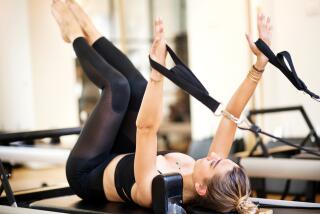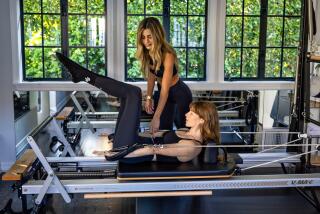Pilates is a ‘guy thing’ too
- Share via
I am a guy in my mid-30s who works out two to four days a week. I have started to feel some lower-back discomfort when I am at my desk during the day, and my abs are not as strong or tight as I would like them to be. I have heard Pilates is great for improving both of these things, but I don’t really understand what it is. And it seems to be only women who take Pilates at my gym. Will Pilates work for men too?
Scott
Long Beach
Pilates (often called the Pilates Method) was created by Joseph Pilates in New York City in the 1920s. A boxer and self-defense trainer, Pilates believed that modern lifestyle, bad posture and inefficient breathing were the roots of many health problems. He devised his own series of exercises, training techniques and special equipment to keep the body balanced, align the spine, strengthen the core muscles and teach awareness of breath.
Because Pilates encouraged controlled movements and precise techniques and avoided using heavy weights, his method quickly became popular in the performing arts community. Well-known dancers (including Martha Graham) became devotees of his methods, which may explain its early association with women. But Pilates himself did not intend for his workouts to be thought of as “for women only,” and Pilates fundamentalists are quick to point out that the method has masculine roots. Pilates died at age 87 and practiced what he preached up until his passing.
Only a handful of instructors trained directly under Pilates, but thousands now teach the Pilates method or “Pilates-inspired” workouts. There is no legal regulation for this method of exercise, and instructors can vary greatly in their styles, expertise and experience.
Fitness experts estimate that less than 15% of Pilates students are men, but that number is growing rapidly as more men begin to see the benefits such training can provide. Many professional sports teams have added Pilates to their training regime -- as have well-known male athletes and celebrities (golfer Tiger Woods among them).
There are two basic types of Pilates workouts: mat workouts and equipment-based workouts. Mat workouts are often done in a class setting with little or no equipment and can be found at most gyms. These classes contain a variety of calisthenic-type movements with very specific instructions. Equipment-based workouts are usually conducted in private or in small group settings and use large machines that make the most of straps, springs and railings. Mat workouts are often included in gym memberships; equipment-based workouts usually cost extra.
Whatever type of Pilates workout you choose, the exercises can seem deceptively easy at first. They become progressively more difficult. But every exercise has a modification, and good instructors will tailor the workout to suit your needs. The beauty of Pilates is that it focuses on controlling movements, so you will never feel rushed or expected to keep up a pace that is beyond your ability.
If you are too intimidated to take Pilates on your own, ask your wife, girlfriend or a female friend to go with you. The men I know who take Pilates swear by it and often say their abs look better than ever, their backs feel stronger and they stand an inch taller.
--
Jay Blahnik, a Laguna Beach-based personal trainer and IDEA Health & Fitness Assn. spokesman, has appeared in more than 25 videos and is the author of “Full-Body Flexibility.” He can be reached at [email protected] or [email protected].


